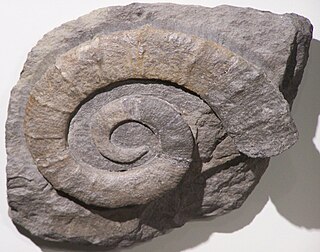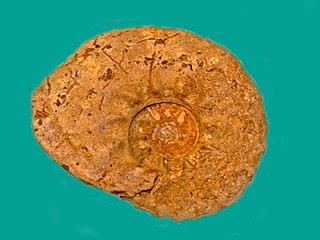| Crioceratidae Temporal range: Hauterivian–Aptian | |
|---|---|
| Scientific classification | |
| Kingdom: | Animalia |
| Phylum: | Mollusca |
| Class: | Cephalopoda |
| Subclass: | Ammonoidea |
| Order: | Ammonitida |
| Superfamily: | Ancyloceratoidea |
| Family: | Crioceratidae Wright 1952 |
The Crioceratidae constitute a family of loosely to closely coiled Ammonitida included in the Ancyloceratoidea that lived during the Early Cretaceous; characterized by Crioceratites and other genera such as Hoplocrioceras and Paracrioceras .

Ammonitida is an order of more highly evolved ammonoid cephalopods that lived from the Jurassic through Cretaceous time periods, commonly with intricate ammonitic sutures.
Ancyloceratoidea, formerly Ancylocerataceae, is a superfamily of typically uncoiled and loosely coiled heteromorph ammonoids established by Alpheus Hyatt in 1900, that may contain as many as 11 families, depending on the classification accepted.

Crioceratites is an ammonite genus from the Early Cretaceous belonging to the Ancyloceratoidea.
The Crioceratidae are gyroconic, coiled in a plane, generally with space between the whorls although in some like Balearites the whorls are barely in contact.
Balearites is an extinct ancyloceratin genus included in the family Crioceratitidae, subclass Ammonoidea, from the Upper Hauterivian.
Although distinct in character and not truly heteromorphic the Crioceratidae were included in the American TreatisePart L, 1957, in the Ancyloceratidae as the subfamily Crioceratinae. It is now considered a distinct family as originally proposed by Wright 1952 with the Acrioceratidae, proposed by Vermeulen (2004), a transition between the two.
The Treatise on Invertebrate Paleontology published by the Geological Society of America and the University of Kansas Press, is a definitive multi-authored work of some 50 volumes, written by more than 300 paleontologists, and covering every phylum, class, order, family, and genus of fossil and extant invertebrate animals. The prehistoric invertebrates are described as to their taxonomy, morphology, paleoecology, stratigraphic and paleogeographic range. However, genera with no fossil record whatsoever have just a very brief listing.

Ancyloceratidae is a family of heteromorphic ammonites that lived during the Early Cretaceous. Their shells begin as a loose spiral with whorls not touching which then turns into a straight shaft that ends in a J-shape hook or bend at end. Coarse ribbing and spines are common.
Acrioceratidae is a family of heteromorph ammonites included in the Ancyloceratoidea comprising ancyloceratid-like forms that start off with a coiled juvenile section, followed by a straight or curved shaft ending in a hook. Two described genera are included, Acrioceras and Dissimilites.
Other genera in the Crioceratidae include Aegocrioceras , Menutheocrioceras , and Shasticrioceras.

Aegocrioceras is an extinct ammonite genus of cephalopod from the Lower Cretaceous included in the Ammonitida. It is known from northern Europe.







